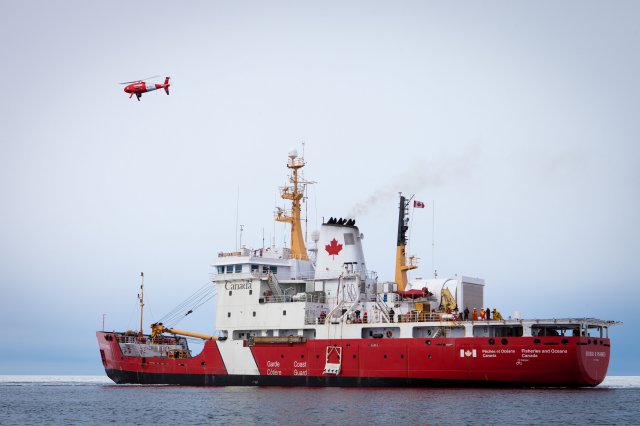At the end of March 2016 at Fogo Island in Canada, Schiebel’s CAMCOPTER S-100 Unmanned Air System (UAS) successfully demonstrated its capabilities to a host of dignitaries from the Canadian Coast Guard, the Royal Canadian Navy, Transport Canada, the Canadian National Research Council and the University of Alaska in partnership with the Memorial University of Newfoundland.
During trials at the end of March 2016, the CAMCOPTER S-100, equipped with the Wescam MX-10S payload camera, once again demonstrated its operational value and mission effectiveness in open waters under icy winter conditions. The combination of the VTOL air vehicle and the Wescam MX-10S camera demonstrated its potential to easily identify vessels, animals and objects at long ranges at sea.
“For the Canadian Government this trial is an important step forward to enhancing our operations by using UAV technology”, explains Marc Garneau, Minister of Transport, regarding the motivations for the trials.
The CAMCOPTER S-100 was deployed aboard the CCGS George R. Pearkes, a light icebreaker of the Canadian Coast Guard. About 60 nautical miles north from Fogo Island, the vessel broke through the ice at speeds of up to 14 knots, guided by imagery from the CAMCOPTER S-100, which offered to the ship’s captain not only a wide view image of the ice structure, but also identified boundaries between flat and rough ice.
Due to the S-100’s operational maturity in the maritime environment and ability to operate in a broad range of weather conditions, it is perfectly suited to support the demands of the Coast Guard. The flight tests included multiple takeoffs and landings in winter conditions. “Once again the CAMCOPTER S-100 has demonstrated it value, flexibility and suitability for maritime operations in hostile environments”, Chris Day, Head of Capability Engineering at Schiebel, stated.
One goal of the trials was the enhancement of situational awareness by transmitting pictures directly and in real time to the ships bridge. This S-100 feature is already well proven, i.e. in the Mediterranean for humanitarian operations, and is easily adapted to support activities related to the conservation and protection of the Canadian fishing grounds.
In a press release issued by the Canadian Coast Guard at the time of the trials aboard the CCGS George R. Pearkes, the Canadian Minister of Fisheries, Oceans and the Canadian Coast Guard, Hunter Tootoo was quoted as saying “I am pleased that the Government of Canada is collaborating in this important initiative. The trial is an excellent opportunity to explore UAV technologies for the enhancement of Canadian Coast Guard services.”
Likewise Kirsty Duncan, the Canadian Minister of Science, agreed that “Science and research play a central role in our Government’s plan to build a thriving economy, and they provide the evidence the Government needs to make sound policy decisions. By conducting leading-edge trials in real environments, we are better able to understand the impacts, benefits and potential applications of this new technology and ensure that the knowledge we gain is shared with our industry and academic partners.”
About Schiebel: Founded in 1951, the Vienna-based Schiebel Group focuses on the development, testing and production of state-of-the-art mine detection equipment and the revolutionary CAMCOPTER® S-100 Unmanned Air System (UAS). Schiebel has built an international reputation for producing quality defense and humanitarian products, which are backed by exceptional after-sales service and support. In 2010, Schiebel’s new composite division has started to supply high-tech customers with products of supreme carbon fiber technology – all quality-controlled to meet ISO 9001 standards. With headquarters in Vienna (Austria), Schiebel now maintains production facilities in Wiener Neustadt (Austria) and Abu Dhabi (UAE), as well as offices in Washington DC (USA) and Phnom Penh (Cambodia).
About the CAMCOPTER® S-100: Schiebel’s CAMCOPTER® S-100 Unmanned Air System (UAS) is a proven capability for military and civilian applications. The Vertical Takeoff and Landing (VTOL) UAS needs no prepared area or supporting launch or recovery equipment. It operates during daytime and at night, under adverse weather conditions, with a beyond line-of-sight capability out to 200 km, both on land and at sea. The S-100 navigates via preprogrammed GPS waypoints or is operated with a pilot control unit. Missions are planned and controlled via a simple point-and-click graphical user interface. High definition payload imagery is transmitted to the control station in real time. Using “fly-by-wire” technology controlled by a triple-redundant flight computer, the UAV can complete its mission automatically. Its carbon fiber and titanium fuselage provides capacity for a wide range of payload/endurance combinations up to a service ceiling of 18,000 ft. In its standard configuration, the CAMCOPTER® S-100 carries a 75 lbs/34 kg payload up to 10 hours and is powered with AVGas or heavy fuel.
Source: Press Release

